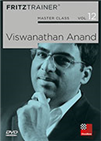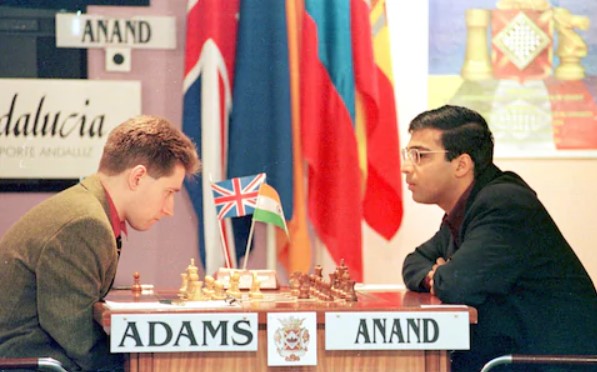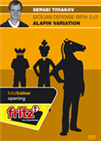MMMG #8: A tough match, a rewarding conclusion
Michael Adams was born in Cornwall on 17 November 1971. Also known as “Mickey”, Adams became a grandmaster at the age of 17, when he received the title after winning the Harringay All-Play-All in London. Two years earlier, he had become the then world’s youngest IM a month before his 16th birthday.
At 48, he is still the highest-rated player in the United Kingdom, placed 28th in the world ranking with a 2716 Elo rating. At several points between October 2000 and October 2002, Adams reached his highest-ever ranking: world number 4.
A seven-time British champion, Adams has participated in World Championship cycles since 1990 until 2019. Three times he reached the semifinals of the knockout tournaments organized by FIDE at the end of the 1990s and the start of the 2000s, losing twice to Vishy Anand (1997 and 2000) and once to Vladimir Akopian (1999). In 2004, he came even closer to claiming the FIDE world champion title, when he was defeated by Rustam Kasimdzhanov in the final after having knocked out Hikaru Nakamura, Akopian and Teimour Radjabov in previous rounds.
His achievements in top-class tournaments are too many to name, but among the most notable were his first place at the 2013 Dortmund Supertournament (7/9, 2923 TPR), and his splendid victory at the 1999 Dos Hermanas Tournament, ahead of Vladimir Kramnik, Miguel Illescas, Veselin Topalov, Anatoly Karpov, Boris Gelfand, Viktor Korchnoi, Peter Svidler, Judit Polgar and Viswanathan Anand.
 This DVD allows you to learn from the example of one of the best players in the history of chess and from the explanations of the authors how to successfully organise your games strategically, and how to keep your opponent permanently under pressure.
This DVD allows you to learn from the example of one of the best players in the history of chess and from the explanations of the authors how to successfully organise your games strategically, and how to keep your opponent permanently under pressure.
Facing Vishy Anand at the 1999 edition of the Linares supertournament
In his most memorable game, Adams looks at the decisive tiebreak game of his match against Sergei Tiviakov at the 1994 PCA Candidates Tournament. Not to be missed!
Adams, Michael vs. Tiviakov, Sergei
PCA Candidates, 1994 - New York
It’s hard to single out one memorable game, but in the end I selected a rewarding conclusion to a long, tough, tense match, where the preceding battles raised the stakes, which made the result even more special. I was also initially tempted to annotate the final game of my match with Nigel Short in the World Championship KO event in Groningen, as that was quite a memorable Christmas day! However, in the end I settled on the decisive tiebreak game of my match with Sergei Tiviakov in the PCA Candidates, over a quarter of a century ago, which despite the passing of time remains a very fond memory.
To set the scene I will give you some information about the match, and the preceding thirteen games. It took place at Trump Tower in New York. I recall the first game being delayed for the guest of honour Donald Trump to arrive — I wonder what that guy is up to now?
The first game took place in rather bizarre conditions: for somewhat unclear reasons the boards had been located near the food court of the shopping centre, where bargain hunters had the bonus of a good view of the games in progress, when ascending the escalators. This proved confusing for some eager shoppers, and not very surprisingly led to rather noisy playing conditions. I had little to complain about as I managed to win that day with black, but it remains something of a mystery as to how this was seen as an appropriate playing hall.

Adams at the 2017 London Chess Classic | Photo: Lennart Ootes / Grand Chess Tour
 Sergei Tiviakov started playing the line 1.e4 c5 2.c3 in the Sicilian Defence as White in 1988. Since then, he has employed it in more than 100 games, including a yearlong period when he I managed to win twelve 2.c3-games in a row. White tries to occupy the centre with a second pawn, and Black must know his stuff very well in order to be able to equalize. And this is only possible with 2...Nf6 – all other lines give the first player a small edge everywhere. Especially against stronger opponents, 2.c3 is an excellent weapon.
Sergei Tiviakov started playing the line 1.e4 c5 2.c3 in the Sicilian Defence as White in 1988. Since then, he has employed it in more than 100 games, including a yearlong period when he I managed to win twelve 2.c3-games in a row. White tries to occupy the centre with a second pawn, and Black must know his stuff very well in order to be able to equalize. And this is only possible with 2...Nf6 – all other lines give the first player a small edge everywhere. Especially against stronger opponents, 2.c3 is an excellent weapon.The next day we had been moved to a quieter venue: a remote art gallery on a higher floor. I will write a little more about this game, as I was able to use some invaluable preparation by my second Julian Hodgson. Jules was highly sceptical about a line, neglecting development in a Rossolimo Sicilian, and angling for queenside castling, which Tiviakov had played a few times before from early in our preparation. Inspiration struck him in the middle of the night, just before the game, as he came up with a much more convincing follow-up to a piece sacrifice that had been played before.
Those were quite different times in terms of electronic help — I remember that it took Jules quite some time to persuade me of how strong this was, as without powerful engine backup things seemed much less straightforward at the time. If you turn on your computer now, it regards the black position as a smoking ruin, with assessments of +4 or more, and many good continuations available. It does reassuringly endorse Julian’s novelty as the best way to proceed, and this move also had the advantage that it was simple enough for even me to follow up correctly, and I won a morale boosting miniature.
After this, the match started going rather wrong from my point of view. In the next two games my opponent showed his resilience, and confidently equalized the score, and we became engaged in a protracted battle. I regained the lead in game 6, but couldn’t maintain it as I lost the next game. The final classical game was drawn, and we headed into tiebreaks.
At this stage of the match I was definitely on the back foot, surviving with black, and making little impression with white, but the first five games didn’t break the deadlock all ending in draws. I am annotating the sixth tiebreak game for this article. I believe the time limit for this game was 15 minutes without increment — pretty swift given the number of moves played.
To avoid theory battles in well-known lines against Ruy Lopez (Berlin, Open Variation or the Marshall Attack), Sergey Tiviakov invites you into the world of an extraordinary early queen move for White: Qe2 – elegant, effective and easy to learn!
Links

























